Top Reasons for Agent Attrition and How to Reduce Call Center Turnover

Recent statistics indicate the average agent attrition rate is between 35 and 45%*.
Every time a call center agent resigns, it causes a domino effect that skyrockets operational costs.
Attrition has an impact that echoes throughout your entire company, often leading to staff shortages, process delays, and, eventually, a lower CSAT score. In fact, 63% of contact center leaders* face staffing shortages and are getting more creative and proactive when it comes to finding, hiring, and retaining agents.
But what if you could skip the step where you lose agents in the first place—saving you time, capital, and energy on recruiting and onboarding skilled agents?
In this article, we explore the top reasons for call center turnover and share actionable tips to help you retain your agents and save on costly replacements.
Key Takeaways:
- High turnover in call centers is often caused by stress, low salaries, and a lack of growth opportunities. Poor training can also harm employee satisfaction and efficiency.
- High turnover has consequences, including increased costs, reduced productivity, a poorer customer experience, and lower team morale.
- Businesses can reduce turnover by offering better training, positive work culture, flexibility, and growth opportunities. Acknowledging achievements and using technology like CloudTalk can further improve retention and performance.
Make better connections with CloudTalk
Understanding Call Center Turnover: Average Rates and Key Causes
One of the key indicators of your company’s health is a low attrition rate. Generally speaking, a healthy turnover rate for most industries is 10% or lower. With this rate, you can consider your company stable. There are no risks of potential disruptions or shortages.
This level of attrition often suggests employees are engaged and satisfied with their work and not likely to leave.
But of course, there’s always an exception to the rule. Call centers are notorious for extremely stressful work environments so it’s no surprise that the call center turnover rate is between 30% and 45%, significantly higher than other industries.
These are the main causes of high call center turnover rates:
- Stressful work environment: Call center agents handle high call volumes, deal with difficult customers, and work under pressure to meet demanding metrics, contributing to emotional exhaustion.
- Low compensation: The average salary for call center agents in the U.S. is approximately $16 per hour, prompting them to seek better-paying opportunities.
- Lack of empowerment: This issue in call centers often stems from rigid processes, limited autonomy, and inadequate access to resources that enable agents to resolve customer issues effectively. Encouraging autonomy can boost productivity and job satisfaction.
- Lack of collaboration opportunities: Working in a call center environment can feel isolating because agents are primarily handling individual interactions with customers while missing opportunities to connect with their peers and share knowledge.
- Limited career development opportunities: Agents who feel they have no future in the company eventually feel stuck and look for career growth in other organizations.
- Poor work-life balance: Many call centers operate 24/7, requiring night shifts, weekends, and holidays. When combined with policies that don’t allow flexible schedules, remote work, or long hours, balancing personal and professional life becomes challenging. Answering calls after business hours is something that can be automated easily.
- Monotonous work: Agents often answer similar questions, resolve recurring issues, and follow predefined scripts for each interaction. Over time, this routine can push them to seek more exciting and innovative opportunities.
- Insufficient training: Agents who don’t receive enough training may feel insecure when handling complex calls or solving problems. This leads to stress and frustration, making them more likely to quit their jobs.
Start the retention process when the person is still open to staying and not after they’ve already told you they’re leaving.
– Jeff Weiner, LinkedIn, Executive Chairman
Keep your agents engaged and customers happy
What Are the Business Risks of High Agent Attrition?
High turnover in call centers is like constantly replacing parts of an engine while it’s running: not only is it costly and exhausting, but it also slows down the entire system and puts its functionality at risk. Its consequences extend beyond call center operations, affecting the business’s overall performance.
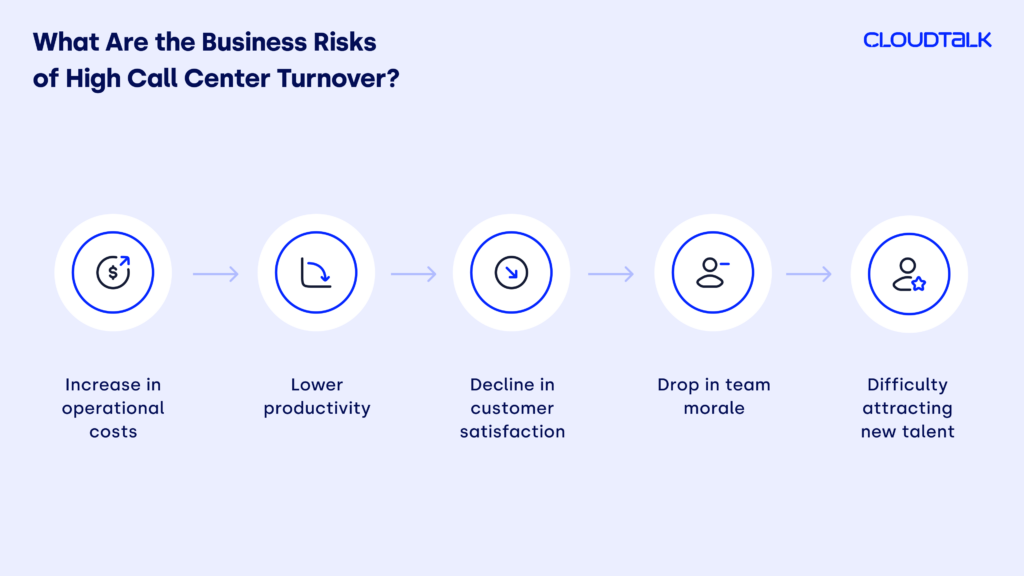
- Increase in operational costs: Hiring a new agent costs $10,000 to $20,000. Replacing just 4-5 agents a month can drain over $100,000—a significant hit to your budget every single month.
- Lower productivity: When an agent leaves, workflow is disrupted, and their knowledge and experience are lost. Time and resources go to hiring and training replacements, slowing efficiency. Meanwhile, remaining team members may feel overworked, further hurting performance.
- The decline in customer satisfaction: During the average 90-day adaptation period, new agents are more likely to make mistakes, give inaccurate responses, and show a lack of confidence, affecting how customers view service quality. Customers also value consistent and familiar interactions, which are hard to provide with a constantly changing team.
- Drop in team morale: A high attrition rate directly affects the overall team’s morale and it can easily lead to burnout. It is estimated that 67% of sales professionals are close to burnout, and a high turnover rate doesn’t help at all. Creating an environment of instability and uncertainty is not a solid foundation for further growth. Remaining agents often have to take on the responsibilities of those who leave, increasing their stress and exhaustion.
- Difficulty attracting new talent: High turnover often points to problems like a poor work environment or limited growth opportunities. This can deter new applicants, making hiring even harder and creating a vicious cycle.
How To Calculate Agent Attrition and Turnover Rate
Turnover rate is an essential metric, as it helps you evaluate call center employee retention and identify potential issues in the workplace environment.
To calculate it, use the following formula:
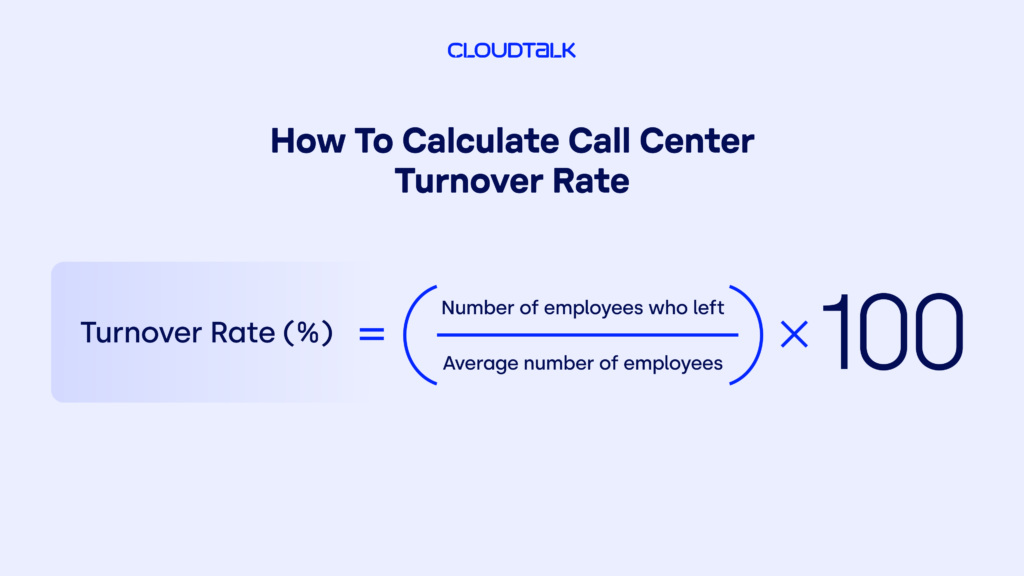
Let’s assume you’re analyzing turnover in your call center over a quarter:
Period data:
- At the beginning of the quarter: 200 agents
- At the end of the quarter: 200 agents (no staff increase)
- Agents who left during the quarter: 60 agents
- Agents who join during the quarter: 60 agents
Step 1: Calculate the average number of employees:
Average = (200 + 200) / 2 = 200
Step 2: Apply the formula:
Turnover Rate = (60 / 200) × 100 = 30%
When calculating the call center turnover rate, consider these key aspects:
Industry standards: As mentioned, average turnover rates for call centers typically range from 30% to 45%, depending on the location and industry.
Time period: Choose a consistent time frame for analysis (e.g., monthly, quarterly, or annually).
Voluntary vs. involuntary turnover: Break down the turnover rate to spot trends (e.g., resignations vs. dismissals).
Pro tip
Take control of your schedule with CloudTalk’s Agent Status. Let agents set their status and see agent availability instantly at the team level. Improve work-life balance and job satisfaction while ensuring your team is always ready for seamless customer interactions.
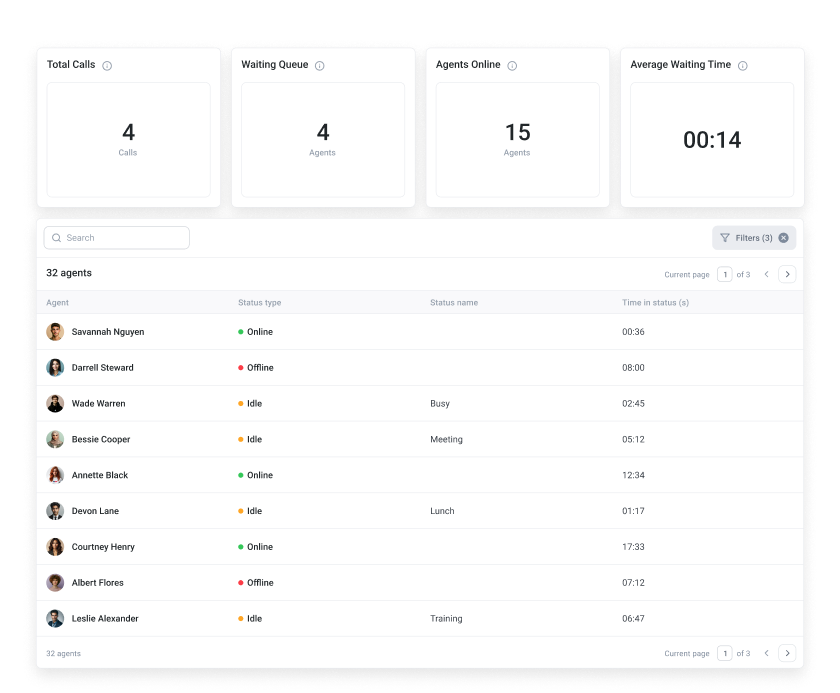
10 Tips To Reduce High Call Center Turnover
High turnover rates in call centers severely impact a company’s financial performance. Every time an employee leaves, costs like recruitment, training, productivity losses, and customer dissatisfaction impact ROI.
Let’s look at a real-life example to make its impact clearer.
Real-Life Example
Imagine a call center with 100 agents and an annual turnover rate of 40%. This means that 40 agents leave the company each year.
Let’s assume that recruiting, training, and covering productivity losses cost an average of $10,000 per agent.
The total annual turnover cost would be: 40 agents × $10,000/agent = $400,000
Now, imagine that after analyzing this data, you implement employee retention strategies in your call center and reduce the turnover rate to 20%.
With this new rate, only 20 agents leave the company each year.
The new turnover cost would be: 20 agents × $10,000/agent = $200,000
This means that if turnover previously cost you $400,000 per year, it now costs $200,000, allowing you to save $200,000 annually. As a result, you’re cutting operational costs in half, significantly improving your ROI.
Want to achieve these impressive savings? Start reducing your turnover rate with the following tips.
Prevent Burnout and Boost Morale With CloudTalk
#1 Optimize Your Recruiting and Hiring Process
Optimizing your agent attrition rate should be done at the very beginning, by screening your candidates. A strong company culture can lower employee turnover by up to 50%. Utilizing pre-hiring skill assessments helps identify candidates who align the best with the company’s values and beliefs, ensuring the best possible cultural fit. This fosters higher employee satisfaction and engagement, reducing the likelihood of turnover.
Utilizing screening this early in the process minimizes the risk of employees leaving due to mismatched expectations, performance issues, or behavior concerns that proper screening could have identified. As a result, it supports a more stable workforce and boosts employee retention.
Quick Tip
You can record phone interviews automatically, making it easy to review them later with your team and assess candidates’ responses and behavior more effectively.
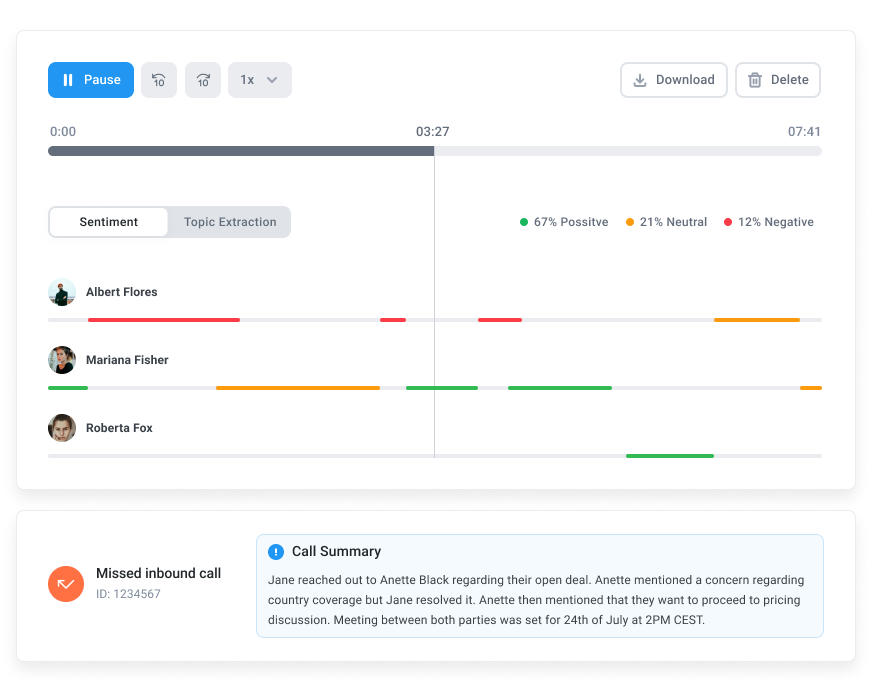
Finding and retaining top talent doesn’t happen overnight. It requires intentional planning and continuous effort, but the payoff is more than worth the investment.
– Matt Herman, Enhance Health, CEO
#2 Improve Training and Onboarding Programs
Only 52% of employees believe their employer is providing them with a proper training program. On the other hand, companies that provide employee training generate more than twice the income per employee and achieve a 24% higher overall profit margin.
Better training helps agents grow professionally, improve their skills, and feel more prepared for their tasks.
Quick Tip
With a Real-Time Dashboard, you can view real-time agent performance data, including average handling time and total calls. This analysis helps identify areas for improvement and tailor training to each agent’s specific needs, enhancing their professional growth.
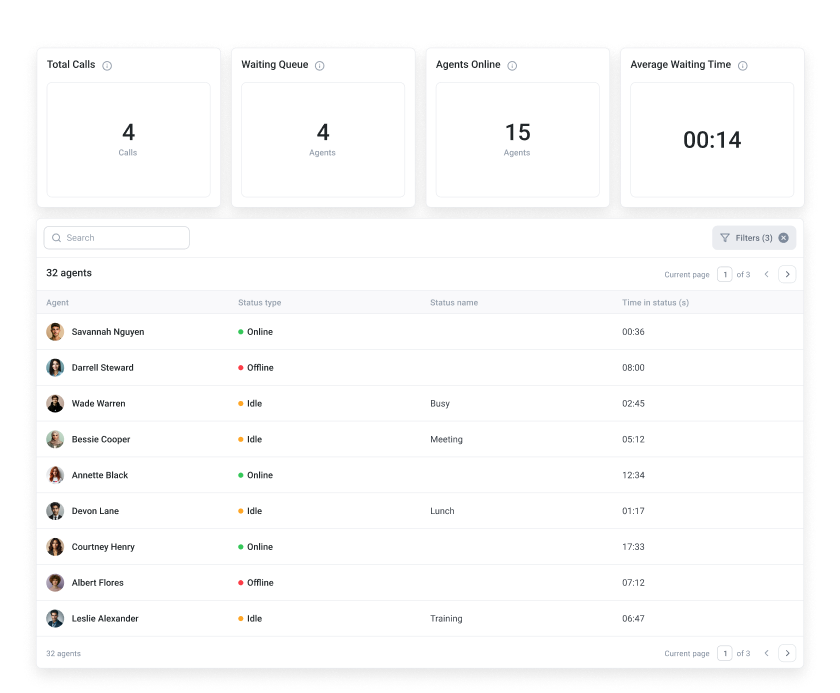
#3 Reward and Recognize Good Work
Recognition goes a long way. Employees who receive monthly recognition are 36% more likely to be productive and engaged, and 22% more likely to demonstrate high commitment to their roles.
A simple pat on the back can make agents feel valued and give them a boost to keep performing at their best.
Quick Tip
Detailed Analytics provide insights into agent performance, including call resolution rates, customer satisfaction scores, and call volume handled. Using this data, you can identify top performers who consistently exceed expectations.
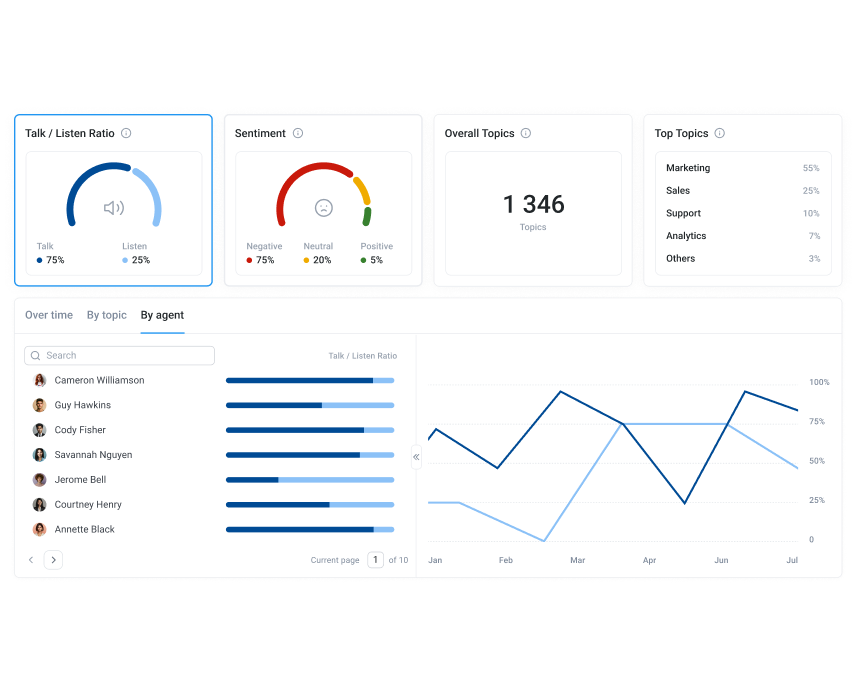
Recognizing hard work and celebrating achievements is a strategic approach that can greatly impact employee retention.
– Thomas Smale, FE International, CEO
#4 Foster a Positive Work Culture
Company culture isn’t just a trending buzzword on LinkedIn.. In fact, a strong company culture can lead to a 65% lower turnover rate than those with a weaker culture. When the workplace is positive, with strong communication and a culture of respect, employees feel more satisfied, engaged, and motivated to stay.
Quick tip
Supervisors can use Call Monitoring and whispering features to provide real-time coaching to agents. This creates a supportive learning environment where employees feel guided rather than criticized, promoting mutual respect and growth.
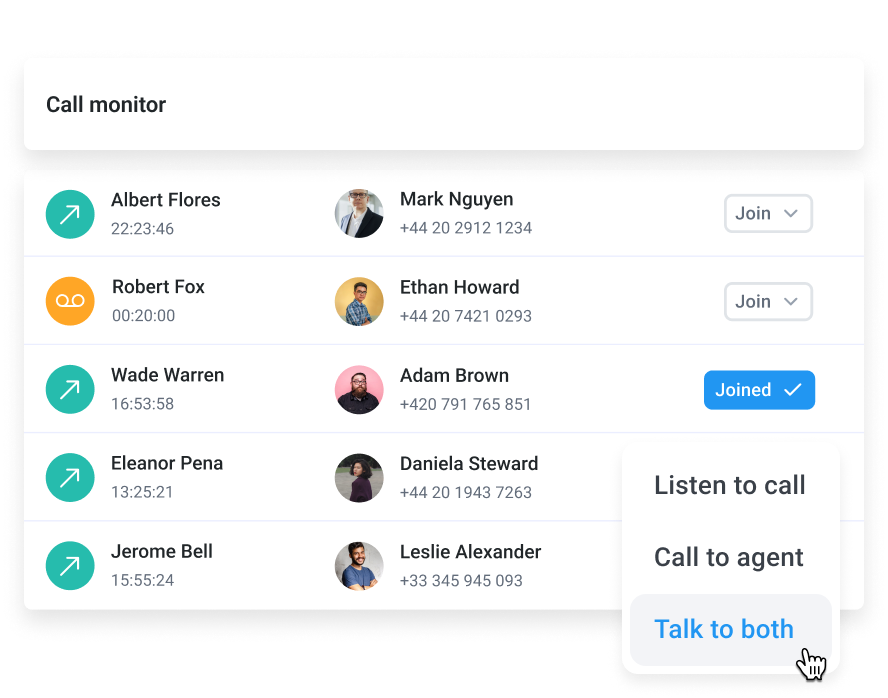
#5 Leverage Technology
Using technology like call center software reduces turnover by streamlining daily tasks and enhancing the agent experience. It automates repetitive processes like call routing and data entry, ensuring agents spend more time on meaningful interactions rather than tedious tasks.
Quick tip
With CloudTalk’s Click-to-Call feature, agents can make calls directly from their CRM or helpdesk software without dialing manually. This saves time and reduces errors, allowing agents to handle more interactions in less time.
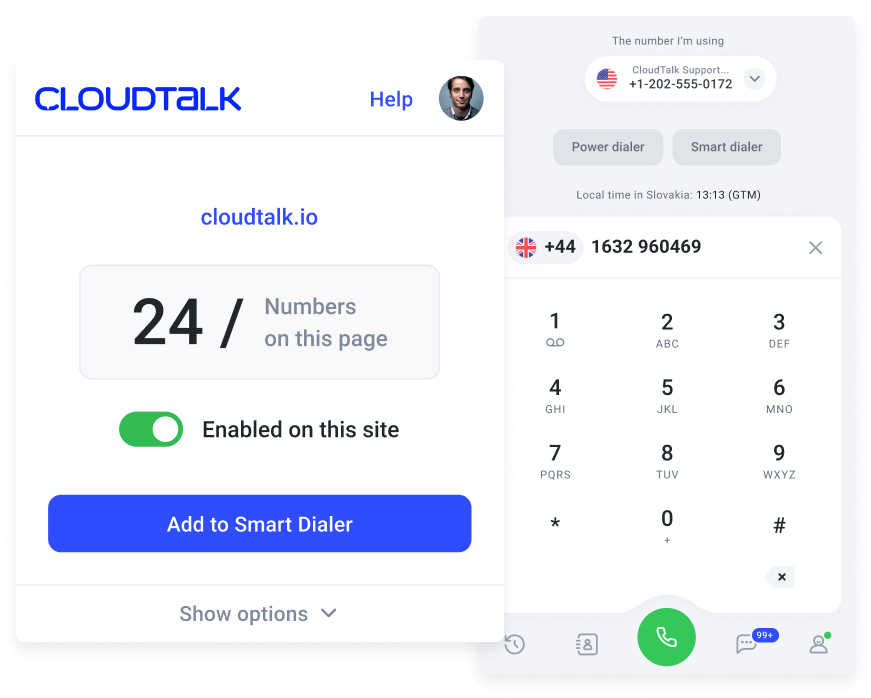
#6 Provide Professional Development Opportunities
One key factor often overlooked is a sense of purpose. When employees’ goals align with the company’s, it’s easier to get everyone working toward a common goal. Coupled with growth opportunities and strong leadership support, it naturally leads to motivated and engaged employees.
So, it’s no surprise that employees with access to professional development opportunities have a 34% higher retention rate than those without them.. If agents feel their employer is committed to helping them grow professionally, they will stick around longer instead of searching for better opportunities while giving the bare minimum at work.
Quick tip
Use features such as Skill-Based Routing to match agents with calls that align with their expertise. As they gain confidence handling these calls, they can gradually be assigned more complex scenarios, helping them expand their skill set in a controlled, supportive way.
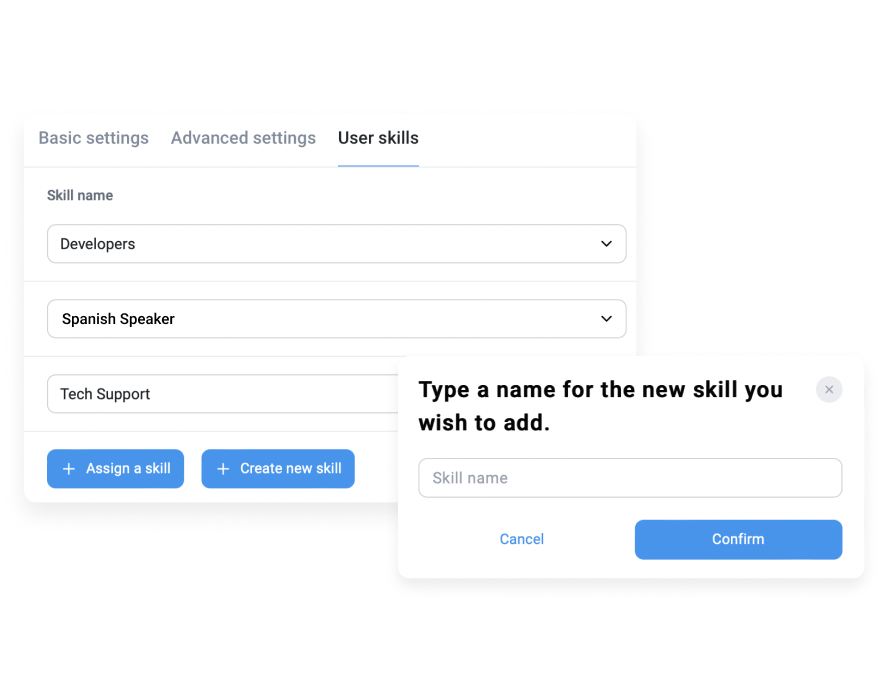
When employees are given opportunities to learn, grow, and pursue their goals, they feel valued and engaged. Moreover, organizations that prioritize employee development tend to attract and retain top talent more effectively, as individuals are drawn to companies invested in their personal and professional growth.
– Dr. Charles Tawk, Merc Training & Consulting, Partner
#7 Offer Flexible Schedules
Companies offering remote work flexibility experience a 25% lower employee turnover rate compared to those that don’t. Remote work flexibility significantly impacts turnover by allowing agents to balance their work and personal lives, reducing stress and increasing job satisfaction.
Quick tip
Implement a cloud-based phone system so agents can log in and handle calls from anywhere with an internet connection. This will allow agents to work remotely, offering them the flexibility to balance personal commitments while staying effective on the job.
#8 Establish Transparent Communication Channels
Around 86% of employees and executives identify poor collaboration and communication as the primary reasons for workplace failures.
When employees feel informed about company goals, expectations, and changes, they’re more likely to feel connected to their work and valued by leadership. This helps employees feel more included and engage more deeply with their work and colleagues
Quick tip
Call Notes feature allows agents to leave detailed notes after calls, which are accessible to the entire team. This promotes collaboration by ensuring everyone has the context they need to continue serving customers effectively.
#9 Communicate Your Vision
Companies with leaders regularly communicating their vision and goals have 50% higher employee engagement levels. No matter their role, everyone in your company deserves to understand the organization’s vision and future goals. Clear communication of this vision helps them see how their efforts contribute to overall success.
Quick tip
Share a story in a team meeting about how a customer praised an agent for solving a complex issue, explaining how that interaction built loyalty and aligned with the company’s mission of excellent customer service.
#10 Conduct Exit Interviews
80% of companies using exit interviews find they help identify why employees leave, improving retention and workplace culture. These interviews reveal key issues, allowing organizations to fix problems and reduce turnover.
Quick tip
Ask questions like, “What prompted your decision to leave?” to gain detailed and honest insights into the reasons behind an employee’s departure. Open-ended questions encourage departing employees to share their thoughts freely, offering a clearer picture of their experiences, concerns, and motivations.
For example, you might follow up with questions such as:
– “What aspects of your role or work environment did you find most challenging?”
– “Were there any resources, tools, or support that could have made your experience better?”
59% of Call Center Employees Face Burnout Risks, With 28% Nearing Acute Burnout Syndrome
In fact, 76% of employees already report experiencing symptoms of burnout. Even if your agents aren’t showing signs yet, it’s crucial to act now to prevent burnout from taking hold—saving your team’s well-being, retaining skilled agents, and protecting valuable resources.
Reducing call center turnover starts with effectively understanding and addressing the root causes. Investing in top-quality call center software can help you spot underlying issues before they happen. It simplifies workflows, eliminates repetitive tasks, and equips your agents with the tools they need to be more efficient and satisfied. This single decision will save you time, money, and unnecessary stress.
Looking for the technology to make it happen? CloudTalk is designed to tackle high turnover with features like AI-powered analytics, Automated Workflows, Power Dialer, and seamless CRM integrations. This means more engaged agents, easier reporting, reduced costs, and a team that stays with you longer.
Optimize your call center KPIs
Source
- YesAssistant. What is agent attrition? 2023
- Forbes. Recent Research Suggests That Something Has To Change In The Contact Center Space. 2023.
FAQs about Agent Attrition
What is call center attrition?
Contact center attrition refers to the rate at which employees leave their positions within a call center over a specific period. Agent attrition is one of the most common call center challenges, besides burnout.
How do you calculate the call center attrition rate?
Calculate the call center attrition rate with this formula: (Attritions / Average employees) x 100.
Do call centers typically have a high agent turnover?
Yes, call centers typically experience high turnover rates, averaging between 30% and 45% annually.
What is the difference between turnover and attrition in a call center?
You can reduce BPO attrition by improving training to prepare employees effectively and offering flexible work options to enhance work-life balance and satisfaction.
How do you control attrition as a team leader?
To deal with call center work, agents should be taught not to take rejection personally. Regular breaks also make shifts less stressful.
How do you control attrition in BPO?
You can reduce BPO attrition by improving training to prepare employees effectively and offering flexible work options to enhance work-life balance and satisfaction.
























